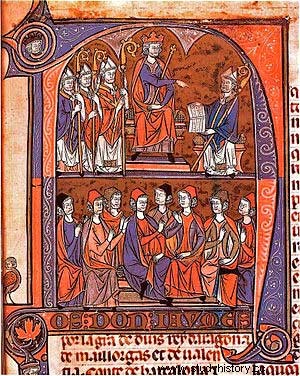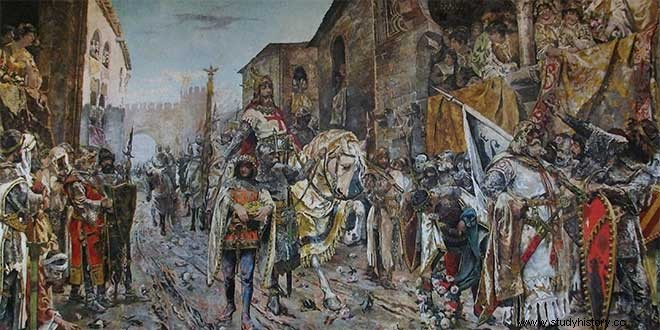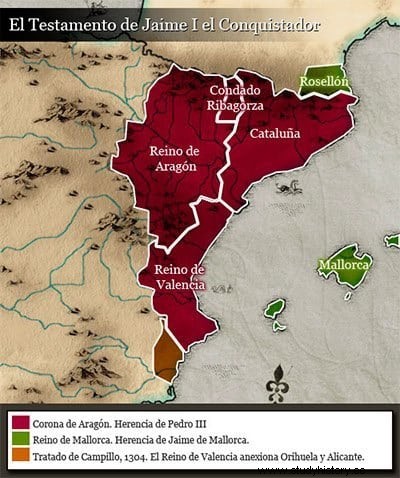Jaime I of Aragon, The Conqueror , king of Aragon and count of Barcelona, whose government occupies more than sixty years of the history of the 13th century, during which he incorporated Valencia and the Balearic Islands into his dominions, set with Castile the limits of the reconquest expansion and began the Mediterranean expansion of his kingdom, at the same time that he definitively renounced territorial ambitions in the south of France. Likewise, great advances were made in the legal fields (fur de Valencia, Cortes, municipal organization), literary (consecration of Catalan with the Llibre dels feyts), commercial and artistic.
Information about Jaime I of Aragon
1208 He is born in Montpellier.
1213 He succeeds his father on the throne.
1227 He initiates the personal government of him.
1229 He undertakes the conquest of Majorca.
1238 He conquers Valencia.
1276 He dies in Valencia.
Jaime 1 was conceived almost two years after his father, Pedro II el Católico de Aragón, had repudiated his mother, María de Montpellier, and requested the annulment of the marriage to Pope Innocent III, who always refused to grant it. According to some chronicles, the queen, who was opposed to the dissolution of the marriage, devised a stratagem by which she surreptitiously substituted a mistress of King Pedro in bed and managed to get pregnant. The boy was born on February 2, 1208 and, even in his cradle, he was the object of an attack and remained in the custody of his mother, but in 1211 he was snatched from him by Pedro II to hand him over to Simón de Montfort as a hostage. The king of Aragon at that time was in a serious political and military situation before the advances of the Ada cross against the Albigensians in the south of France.
The great interest of the Catalan-Aragonese crown in the south of France was increased, in the case of Pedro II, by the alliances that derived from his undissolved marriage with María, who in 1203, on the death of her father, had inherited Montpelier. The Albigensian doctrine, based on a Manichean-type system; It rejected the ecclesiastical hierarchy, wealth and property rights, which allowed among its followers or collaborators to find the bourgeoisie and the popular classes of Languedoc and Occitanie, which were the regions in which the sect had the greatest roots, as well as a large part of the feudal lords of the region, eager to appropriate the ecclesiastical lands. In 1208 Innocent III had a crusade preached against the Albigensians , which was left under the command of Simon de Montfort, who, at the head of an army of knights from the north of France, devastated Languedoc; the crusade thus became a struggle between the Languedoc nobility and the royal power of the Capetians of northern France.

In this situation, Pedro II received a request for help from his vassal, the excommunicated Count of Tolosa. In 1213 the king was forced to intervene and, with the halo achieved by his decisive participation in the battle of Las Navas de Tolosa, he launched himself at the head of his troops against the enemy. The decisive clash took place at Muret, where he was defeated and killed by Simon de Montfort. Thus, at the age of five, Jaime inherited the domains of his parents and became a hostage king. The Aragonese nobility sent an embassy to the pope to ask for the child's release. An energetic bull from Innocent III made Simon de Montfort release him in 1214, after which he was recognized as king of Aragon and Catalonia and, as determined by the will of Maria de Montpellier, who had died the previous year, he was handed over to the custody of the Templars. In Monzón, one of the strongholds of the order, Jaime I was educated by the Grand Master of the Temple while his uncle Sancho, Count of Roussillon, exercised the regency.
Sancho wanted to continue the policy of intervention in the south of France that had characterized the Crown of Aragon and, despite the pope's opposition, continued the fight against Simón de Montfort. Meanwhile, in Aragon the fights between the feudal barons became endemic and Sancho was forced to give up part of his powers. In 1217 the king was taken to Zaragoza , where he was little more than a prisoner of the nobility. In 1220, at the age of thirteen, he was married to the infanta Eleanor, daughter of Alfonso VIII of Castile, by whom nine years later he had a son, Alfonso; this marriage was declared dissolved in 1229 by the Council of Lérida, meeting at the request of the king, due to the too close degree of kinship between the couple, although the same council recognized the legitimacy of Alfonso.
Between 1222 and 1226 Jaime I took part in several major war actions, such as the siege of Castejón or the unsuccessful campaign against Peñíscola, in which he gained experience as a warrior. In 1226 he prepared an expedition against Teruel which was ultimately not carried out due to the alliance between this city and the Muslim king of Valencia, with whom a truce had been concluded. As a result of a discussion about the convenience of respecting the truce, Jaime I, a supporter of it, got into a hand-to-hand fight with one of his nobles, who was killed by a supporter of the king when he got involved in a brief fight between them. presents. This death provoked a harsh uprising against Jaime I, in which a large part of the nobility intervened. The king managed to dominate the situation and in 1227, at the age of nineteen, he began his personal government after reaching the Peace of Alcalá, an agreement by which the Bishop of Lérida, the Archbishop of Zaragoza were appointed as arbiters of possible conflicts. and the Master of the Temple. One of the fruits of this agreement was the restitution of the County of Urgel to the Countess Aurembiaix, who declared herself a feudatory of the crown and became the king's lover.
The conquests
In 1228, the courts of Barcelona approved, to protect the trade of the Catalan ports, an expedition to conquer the Balearic Islands. The army of King Jaime I left the ports of Tarragona, Salou and Cambrils in September 1229 and the landing took place in Santa Ponsa. The hard battle of Porto Pi took the expeditionaries to the capital, which was under siege for three months and was taken by storm on December 31, 1229, with the direct intervention of the king. The campaign lasted until 1232 and was completed in 1235 with the conquest of Ibiza .
Meanwhile, the old King Sancho VII el Fuerte de Navarra, who had traditionally maintained excellent relations with the Crown of Aragon and was suspicious of Castilian intentions, promoted a treaty with Jaime I by which both monarchs adopted each other. This treaty, signed in Tudela in 1231, favored Jaime I insofar as he was considerably younger than his adoptive father and, predictably, would inherit the crown of Navarre. Despite the fact that Sancho VII died three years later, the pact was not fulfilled, among other reasons due to the fear of the rest of the monarchs of Christendom, including the pope, of the power resulting from a kingdom that arose from the union between those of Navarre. and Aragon.
In 1232 the Monzón courts decided on the conquest of Valencia, which had begun as a private enterprise with the taking of Morelia and was decisively continued by the king through the conquest of Burriana in 1233 and a slow advance towards the capital. In 1235 Jaime I married Princess Violante of Hungary , who contributed an important monetary amount as a dowry and some territories that were never effectively governed by Jaime I or his successors; instead, the king undertook to give the Balearic Islands and what he conquered in Valencia to the children he had with Violante. Both the monetary contribution and her interest in her children led Queen Violante to promote the conquest of Valencia and try to
accentuate the differences between the king and his eldest son Alfonso.
In 1237, in Valencian lands, Jaime I swore that he would not cross the Ebro again until he had conquered the city of Valencia, which surrendered in September 1238. A later campaign, destined to conquer Játiva, Alcira and Biar, gave rise to a serious conflict between Jaime I and the infante Alfonso, heir to the Castilian crown who would become Alfonso X el Sabio. After a difficult negotiation in which the energy of Jaime I and the intervention of Queen Violante stood out, the Treaty of Almizra was signed in 1244 , which definitively set the limits of the Castilian and Catalan-Aragonese conquests in a line that passed through Biar and the Sierra de Villena. Despite this treaty and the ties of kinship created between the royal families of Castile and Aragon by the marriage between Alfonso X and Violante de Aragón, daughter of King Jaime I, relations between the two great peninsular kingdoms reached moments of tension, mainly on the occasion of the Muslim uprising in Valencia in 1254, who were covertly supported by the already King Alfonso X of Castile. Two years later, in an interview held in Soria, Jaime I and his son-in-law Alfonso X managed to establish a climate of cooperation that would reach its most tangible result in 1265 when the Conqueror, against the opinion of his nobility, especially the Aragonese barons , launched himself into the conquest of the kingdom of Murcia, which had been a Castilian protectorate for twenty years, and after a quick campaign he handed it over to Castile in 1266.

The partition of the kingdoms
Jaime I was a great military leader and showed signs of extraordinary personal courage; However, the king frequently made major political errors, among which the partition of his kingdoms among his heirs stands out. In 1248 the testamentary provision of the king was known according to which Alfonso, his eldest son, son of Eleanor of Castile, would receive the kingdom of Aragon; Pedro, future Pedro III the Great, first of the children with Violante of Hungary, would reign over Catalonia, the Balearic Islands and the county of Ribagorza; to Jaime, future Jaime II of Majorca, son also of Violante,:he destined Valencia; finally, Fernando would inherit Roussillon.
The infant Alfonso was dissatisfied with this distribution, which was detrimental to his interests, as the eldest son, and his differences with the king reached such a point that in 1250 the courts of Alcañiz appointed a jury with the mission of resolve the conflict. The deaths of Alfonso, Fernando and Violante of Hungary forced to modify the agreements reached until then, without abandoning the idea of division of the territories governed by the Conqueror. The disagreements between the infantes Pedro and Jaime were a factor of added difficulty to the new distribution, which was definitively established in 1262:Pedro, who secretly contested the new testament of his father, would receive the kingdoms of Aragon and Valencia and the county from Barcelona; Jaime, the kingdom of Mallorca, the counties of Roussillon, Colliure, Conflent and Vallespir and the lordship of Montpellier. This secession of the Catalan-Aragonese dominions effectively took place on the death of the king and was maintained for three quarters of a century.
In 1258, shortly before the definitive partition was established, Jaime I signed the Treaty of Corbeil with King Louis IX of France, according to which Jaime I renounced any claim on the territories of southern France, with the exception of the lordship of Montpellier, in exchange for the renunciation of the French sovereigns to the feudal rights that they could claim as descendants of Charlemagne. This treaty and the renunciation of his rights over Provence, carried out the same year by Jaime I, indicate a change of orientation in the foreign policy of the Catalan-Aragonese crown, which stopped its ultra-Pyrenean expansion to initiate a policy of greater openness towards the Mediterranean. . In this sense, the marriage celebrated in 1262 between his son Pedro, who had become the eldest son at the death of the infante Alfonso, and Constanza de Sicilia should be interpreted. Another example of this policy was the organization of a crusade to the Holy Land. In 1269 the royal squadron sailed from the port of Barcelona, but was dispersed by a storm a few days later. The king's ship returned to Barcelona, while several of its ships reached San Juan de Acre, where its crew, lacking an undisputed command, resigned from the company, a company that has been considered a precursor to the Almogavar expedition to the East.

The last years of the reign of Jaime I were almost as eventful as those of his minority. The king's discrepancies with his son Pedro, who proved to be a man of great energy, and his with Fernando Sánchez de Castro, bastard of Jaime I and his favorite, were added to noble revolts and a serious Muslim uprising in the south. From Valencia. Pedro exonerated his father from the crown attorney general's office, laid siege to his half-brother Fernando in the castle of Pomar and had him thrown into the Cinca. As for the Muslim uprising, the king himself went to put down the rebellion, but was defeated in Luxent and was forced to withdraw to Valencia while his son Pedro took command of the troops. Jaime I died in Valencia on July 26, 1276 , five days after having abdicated in favor of the infantes Pedro and Jaime.
The chronicles of his time present Jaime I as a beautiful, tall, sensitive, deeply religious man, despite having been excommunicated in 1237 for insulting the archbishop of Zaragoza and for having made the bishop of Gerona cut out his tongue, and above all as a home of females , as evidenced by his numerous mistresses and illegitimate offshoots. Among the many achievements of his reign, the writing of the Llibre del Consolat del Mar stands out. , first code of maritime customs; the great institutional progress with the introduction of Roman law, the appearance of local compilations such as the furs of Valencia, the structuring of institutions such as the Cortes or the municipal organization; the literary consecration of Catalan as a language with the Libre dels feyts , chronicle of the reign of Jaime I written in the first person, and with the first works of Ramón Llull; the triumph of the Gothic in architecture and the economic and demographic development of its kingdoms.
